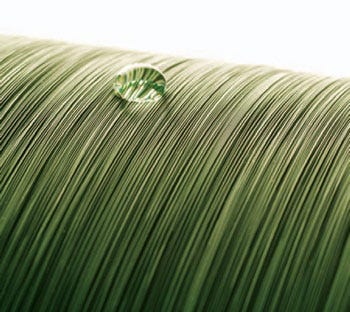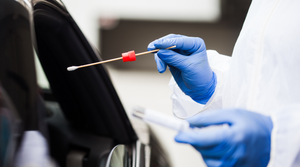For Medical Coatings, Versatility Is the Name of the Game
November 8, 2013
As the use of coatings on medical devices and various components continues to percolate throughout the medical device industry, engineers and designers are finding more and more applications for them. Coating chemistry specialists are improving their formulations, and new applicators are depositing them cleaner, faster, and with more uniformity. This synergistic circle can only have one result: the continuing improvement of patient outcomes.
"The entire medical device industry has need for high-performance coatings for one reason or another," says Don Garcia, director of research and development at Boyd Coatings Research Company, Inc. (Hudson, MA). "In many cases, it is not a case of inventing new coatings; rather, it is finding new places to use them." More than ever, he adds, design engineers are reaching a profound understanding of the value of high-performance coatings in the overall instrument or device. Instead of viewing the coatings as an additional cost, they are seeing it as a value-added proposition that, in the long run, reduces the cost of the device while improving performance.
Coatings Expand Their Capabilities
|
|
Developed in the early 1990s, a spool-to-spool process used by Merit Medical Coatings to coat medical wires and tubes before further processing was likely the first of its kind used in medical device applications. |
|
Formulators continue to broaden the spectrum of choices available to the medtech market. New and improved coatings better address widely accepted uses and may now combine desirable properties such as antimicrobial action, antithrombogenic properties, lubricity, and drug elution in the same coating.
According to Ajay Luthra, CEO of BioInteractions Ltd. (Reading, West Berkshire, UK), the company's new AvertPlus surface active antimicrobial coating is multifunctional. It is specifically designed to be biocompatible, lubricious, and nonthrombogenic, and it can reduce the incidence of device-related infections. The company's Assist enhanced lubricious coating, on the other hand, combines a highly lubricious component with a nonthrombogenic component, providing dual comfort for the patient and superior ease of use. And the firm's Astute advanced Heparin coating, Luthra adds, has both nonthrombogenic and antithrombogenic properties on the same polymer backbone, whereby the coating negates the adverse biological responses that are initiated when tissue comes into contact with a foreign surface.
Meanwhile, a new antimicrobial coating technology from Specialty Coating Systems (Indianapolis, IN; scscoatings.com) is based on microRESIST antimicrobial parylene technology. This system combines the benefits of biocompatible parylene with antimicrobial properties to effectively eliminate harmful microorganisms on coated devices.
Recent introductions in the hydrophilic technology space include Serene lubricious coatings from SurModics Inc. (Eden Prairie, MN). These coatings address the issue of particulates, a topic of regulators' concern. Serene coatings provide lubricity and durability while significantly reducing particulates. In addition, they are optimized for a range of multidurometer catheter substrates and are used on FDA-cleared coronary and peripheral devices. "SurModics continues to develop innovative products and technology platforms that are aligned with the clinical advancements and economic needs of the healthcare industry," notes Charlie Olson, senior vice president and general manager of the company's medical device business.
Coating Application Methods Evolve
Automation and computer control govern the application of coatings. These ever-more-sophisticated control systems are needed for their precision and repeatability to run dipping and spraying operations, spool-to-spool systems, and plasma-based deposition systems.
Merit Medical Coatings (South Jordan, UT) uses a spool-to-spool process to coat medical wires and tubes prior to further processing, according to Camiel Peerlings, the company's general manager. "Merit Medical Coatings is currently validating its newest coating line," he explains. "This addition to our existing line will help us keep pace with the growth we are experiencing." The new coating line, which the company intends to have ready before the end of 2013, incorporates a redesigned drying cycle to improve the consistency of the company's precoated wire products.
Peerlings believes that advances made in the cardiovascular area will soon be employed in other specialties. "Merit Medical Coatings is particularly interested in the neurological medical field," he says, "because we believe that the tight tolerances and high consistency of our precoated products will play an important role in developing the sensitive medical devices required in this area of the body."
|
A variety of medical devices can benefit from SurModics's lubricious coatings. |
Boyd Coatings' Garcia says that his company has integrated the latest advances in robotics and automation equipment and software. In addition to improving process efficiencies, these tools control inputs so that the quality of the coatings application is uniformly precise and repeatable. "We can evenly coat an inside diameter as small as 0.007 in., even if the lumen is long or has bends, flanges, corners, or other obstacles," Garcia comments. Specialized software is frequently updated for all phases of process control--from manufacture and coating application to bar coding, tracking, and the traceability necessary to meet customers' FDA standards.
Finnish-coating technology specialist Picodeon Ltd. Oy (Piisilta, Finland; www.picodeon.com) has developed a technique for depositing diamond-like films onto a variety of substrates using its patented ultra-shortpulsed laser deposition (US PLD) technology.
"Any components that need to have the highest possible hardness or wear resistance can achieve improved life cycles, greater heat and pressure resistance, and improved performance with diamond-like coatings," states Picodeon CEO Marko Mylläri. A cold ablation technology, US PLD deposition works across a wide range of coating materials and substrates. By adjusting processing parameters, the structure and properties of the coating can be tailored to the requirements of the application, even for nanostructure-scale surface coatings. "Our US PLD deposition process," Mylläri adds, "can deliver the exact surface defined by our customers' engineers because of the high level of tuning enabled by our process."
Spire Biomedical Inc. (Bedford, MA) has announced the emergence of its ion-beam-assisted deposition (IBAD) method, a thin-film deposition process that combines evaporation with concurrent ion beam bombardment in a highvacuum environment. The coating material is vaporized using a high-power electron beam. Components are placed in the vapor, and individual coating atoms or molecules condense on the surface of the component to form the coating. Simultaneously, highly energetic ions (100-2000 eV) are produced and directed at the component surface. Concurrent ion bombardment, according to the company, improves adhesion significantly and permits control over film properties such as morphology, density, stress level, crystallinity, and chemical composition. In addition, IBAD is capable of depositing many different types of metallic and ceramic coatings.
Pondering the future of the current device-oriented medtech paradigm, BioInteractions' Luthra wonders, "How long will it last? Who knows. I believe regenerative technology will take over."
About the Author(s)
You May Also Like



